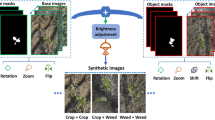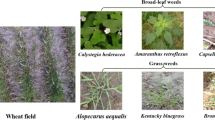Abstract
Difficulties in the recognition of beet seedlings and weeds can arise from a complex background in the natural environment and a lack of light at night. In the current study, a novel depth fusion algorithm was proposed based on visible and near-infrared imagery. In particular, visible (RGB) and near-infrared images were superimposed at the pixel-level via a depth fusion algorithm and were subsequently fused into three-channel multi-modality images in order to characterize the edge details of beets and weeds. Moreover, an improved region-based fully convolutional network (R-FCN) model was applied in order to overcome the geometric modeling restriction of traditional convolutional kernels. More specifically, for the convolutional feature extraction layers, deformable convolution was adopted to replace the traditional convolutional kernel, allowing for the entire network to extract more precise features. In addition, online hard example mining was introduced to excavate the hard negative samples in the detection process for the retraining of misidentified samples. A total of four models were established via the aforementioned improved methods. Results demonstrate that the average precision of the improved optimal model for beets and weeds were 84.8% and 93.2%, respectively, while the mean average precision was improved to 89.0%. Compared with the classical R-FCN model, the performance of the optimal model was not only greatly improved, but the parameters were also not significantly expanded. Our study can provide a theoretical basis for the subsequent development of intelligent weed control robots under weak light conditions.










Similar content being viewed by others
References
Abouzahir S, Sadik M, Sabir E (2021) Bag-of-visual-words-augmented Histogram of Oriented Gradients for efficient weed detection. Biosyst Eng 202:179–194
Akbarzadeh P, Ahderom, Apopei A (2018) Plant discrimination by Support Vector Machine classifier based on spectral reflectance. Comput Electron Agric 148:250–258
Al-Smadi M, Qawasmeh O, Al-Ayyoub M, Jararweh Y, Gupta B (2017) Deep recurrent neural network vs. support vector machine for aspect-based sentiment analysis of Arabic hotels’ reviews. J Comput Sci 27:386–393
Andrea CC, Daniel B, Misael J (2017) Precise weed and maize classification through convolutional neuronal networks. IEEE Second Ecuador Technical Chapters Meeting (ETCM)1–6
Baareh AK, Elsayad A, Al-Dhaifallah M (2021) Recognition of splice-junction genetic sequences using random forest and Bayesian optimization. Multimed Tools Appl 2021:1–18
Bakhshipour A, Jafari A, Nassiri SM, Zare D (2017) Weed segmentation using texture features extracted from wavelet sub-images. Biosyst Eng 157:1–12
Dai J, Li Y, He K, Sun J (2016) R-FCN: Object detection via region-based fully convolutional networks. In: Advances in Neural Information Processing Systems, pp 379–387
Dai J, Qi H, Xiong Y, Li Y, Zhang G et al (2017) Deformable convolutional networks. In: 2017 IEEE International Conference on Computer Vision (ICCV), pp 764-773
Dinesh Kumar JR, Ganesh Babu C, Priyadharsini K (2021) An experimental investigation to spotting the weeds in rice field using deepnet. Mater Today: Proc 45:8041-53
Everingham M, Eslami S, Gool LV (2015) The pascal visual object classes challenge: a retrospective. Int J Comput Vis 111:98–136
García B, Mylonas N, Athanasakos L, Fountas S (2020) Improving weeds identification with a repository of agricultural pre-trained deep neural networks. Comput Electron Agric 175:105593
Huang H, Deng J, Lan Y, Yang A, Deng X et al (2018) A fully convolutional network for weed mapping of unmanned aerial vehicle (UAV) imagery. PLoS ONE 13:e0196302
Jiang H, Wang P, Zhang Z, Mao W, Zhao B et al (2018) Fast identification of field weeds based on deep convolutional network and binary hash code. Trans Chin Soc Agric Mach 49:30–38
Li H, Wu X (2019) DenseFuse: A fusion approach to infrared and visible images. IEEE Trans Image Process 28(5):2614–2623
Li B, Bai B, Han C (2020) Upper body motion recognition based on key frame and random forest regression. Multimed Tools Appl 79:5197–5212
Lin T, Goyal P, Girshick R, He K, Dollár P (2017) Focal loss for dense object detection. In: IEEE Trans Pattern Anal Mach Intell, pp 2999-3007
Maswadi K, Ghani NA, Hamid S, Rasheed MB (2021) Human activity classification using Decision Tree and Naïve Bayes classifiers. Multimed Tools Appl 80:21709–21726
Milioto A, Lottes P, Stachniss C (2018) Real-time semantic segmentation of crop and weed for precision agriculture robots leveraging background knowledge in CNNs. In: 2018 IEEE International Conference on Robotics and Automation (ICRA), pp 2229-2235
Nogueira K, Penatti OAB, dos Santos JA (2017) Towards better exploiting convolutional neural networks for remote sensing scene classification. Pattern Recogn 61:539–556
Pearse GD, Tan AYS, Watt MS, Franz MO, Dash JP (2020) Detecting and mapping tree seedlings in UAV imagery using convolutional neural networks and field-verified data. ISPRS J Photogramm Remote Sens 168:156–169
Raghavendra R, Dorizzi B, Rao A, Kumar GH (2011) Particle swarm optimization based fusion of near infrared and visible images for improved face verification. Pattern Recogn 44:401–411
Raja R, Nguyen TT, Slaughter DC, Fennimore SA (2020) Real-time weed-crop classification and localisation technique for robotic weed control in lettuce. Biosyst Eng 192:257–274
Ren S, He K, Girshick R, Sun J (2017) Faster R-CNN: Towards real-time object detection with region proposal networks. IEEE Trans Pattern Anal Mach Intell 39:1137–1149
Ren X, Meng F, Hu T, Liu Z, Wang C (2018) Infrared-visible image fusion based on Convolutional Neural Networks (CNN). Intelligence Science and Big Data Engineering: 301–307
Sandoval-Insausti H, Chiu YH, Dong HL, Wang S, Chavarro JE (2021) Intake of fruits and vegetables by pesticide residue status in relation to cancer risk. Environ Int 156:106744
Shin HC, Roth HR, Gao M, Lu L, Xu Z et al (2016) Deep convolutional neural networks for computer-aided detection: CNN architectures, dataset characteristics and transfer learning. IEEE Trans Med Imaging 35:1285–1298
Shrivastava A, Gupta A, Girshick R (2016) Training region-based object detectors with online hard example mining. In: IEEE Computer Society, pp 761-769
Sun J, He X, Tan W, Wu X, Shen J et al (2018) Recognition of crop seedling and weed recognition based on dilated convolution and global pooling in CNN. Trans Chin Soc Agric Eng 34:159–465
Wang H, Li Z, Yang L, Gupta BB, Chang C (2018) Visual saliency guided complex image retrieval. Pattern Recognit Lett 130:64–72
Wang T, Knap J (2020) Stochastic gradient descent for Semilinear elliptic equations with uncertainties. J Comput Phys 426:109945
Wu G, Li Y (2021) CyclicNet: an alternately updated network for semantic segmentation. Multimed Tools Appl 80:3213–3227
Yan B (2018) Identification of weeds in maize seedling stage by machine vision technology. J Agric Mechanization Res 40:212–216
Ying Z, Ge L, Ren Y, Wang R, Wang W (2017) A new image contrast enhancement algorithm using exposure fusion framework. In: Presented at International Conference on Computer Analysis of Images and Patterns, pp 36-46
Zhang J, Li M, Feng Y, Yang C (2020) Robotic grasp detection based on image processing and random forest. Multimed Tools Appl 79:2427–2446
Zhao P, Wei X (2014) Weed recognition in agricultural field using multiple feature fusions. Trans Chin Soc Agric Mach 45:275–281
Acknowledgements
This work is partially supported by a project funded by the Priority Academic Program Development of Jiangsu Higher Education Institutions (PAPD-2018-87), Synergistic Innovation Center of Jiangsu Modern Agricultural Equipment and Technology (4091600002). Project of Faculty of Agricultural Equipment of Jiangsu University (4121680001).
Author information
Authors and Affiliations
Corresponding author
Additional information
Publisher’s Note
Springer Nature remains neutral with regard to jurisdictional claims in published maps and institutional affiliations.
Rights and permissions
About this article
Cite this article
Sun, J., Yang, K., He, X. et al. Beet seedling and weed recognition based on convolutional neural network and multi-modality images. Multimed Tools Appl 81, 5239–5258 (2022). https://doi.org/10.1007/s11042-021-11764-5
Received:
Revised:
Accepted:
Published:
Issue Date:
DOI: https://doi.org/10.1007/s11042-021-11764-5




